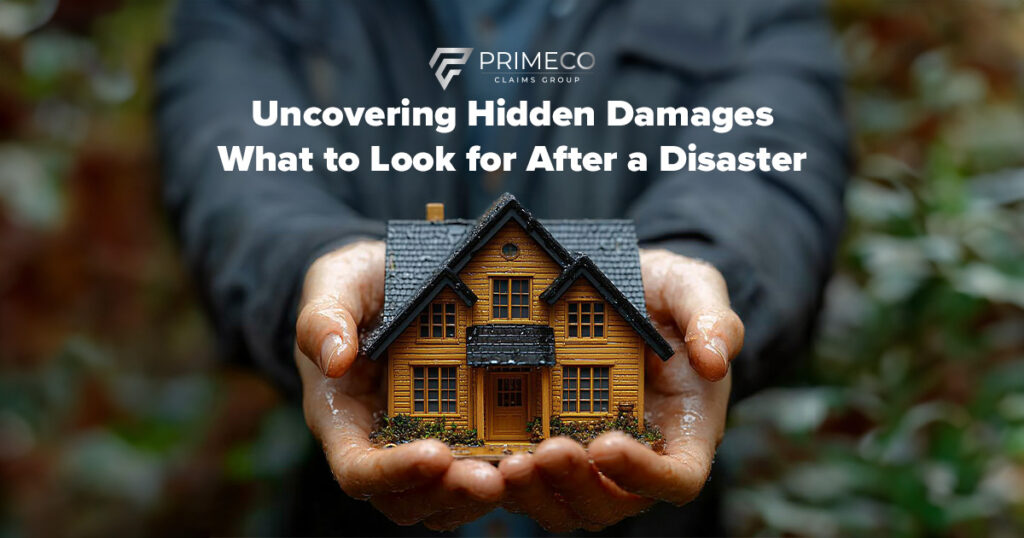After a disaster strikes, visible damage like broken windows, fallen trees, or roof damage is easy to spot and address. However, hidden damages—those that are less apparent but equally problematic—can often be overlooked. At Primeco Claims Group, we understand the importance of a thorough inspection and the role it plays in claims handling. Insurance companies rely on us to ensure that all damages, visible and hidden, are accurately identified and assessed.
In this blog, we explore the types of hidden damages common after a disaster, why they’re important, and how you can spot them to prevent bigger issues in the future.
Why Hidden Damages Matter
While obvious damage demands immediate attention, hidden damages can quietly worsen over time if not identified and treated early. These concealed problems may lead to structural issues, increased repair costs, and even potential health hazards. For insurance companies, this makes thorough inspections critical—not only to ensure a fair claims process but also to protect policyholders from future complications.
By working with Primeco Claims Group’s expert field adjusters, insurance companies can rest assured that both visible and hidden damages are accounted for, helping policyholders receive the proper compensation they need to restore their properties.
Common Types of Hidden Damages
Here are some of the most common types of hidden damages that can occur after natural disasters such as hurricanes, floods, or fires:
1. Water Intrusion and Mold Growth
Water damage is one of the most common issues after storms, especially in the wake of hurricanes or flooding. While surface water damage is easy to see, water intrusion can lead to unseen problems behind walls, under floors, or in the attic. Over time, these moist areas become breeding grounds for mold and mildew, which can cause health problems and structural deterioration. Don’t forget the policy often requires insureds to properly mitigate and help avoid mold growth. Our adjusters will be sure to help determine if proper mitigation occurred and identify potential mold growth.
What to Look For:
· Musty odors
· Discoloration on walls, ceilings, or baseboards
· Soft spots on floors or walls
· Swollen or warped building materials
2. Foundation Cracks
The structural integrity of a building is critical, but foundations can suffer cracks or shifts after a disaster without showing immediate signs of damage. Earthquakes, floods, or the settling that occurs after a major storm can weaken the foundation, leading to larger structural problems. Identifying the problem early, will help avoid future claims filed and deliver a quick determination if the insured has the proper coverage for it.
What to Look For:
· Small cracks in the walls or floors
· Doors or windows that are suddenly difficult to open or close
· Uneven floors
· Water pooling near the foundation
3. Electrical System Issues
Disasters like floods and hurricanes can compromise a property’s electrical system, even if the damage is not readily apparent. Water exposure, downed power lines, or flying debris can cause short circuits, damage to wiring, or faulty connections that may not show immediate effects but can be dangerous over time. If identified, we can help keep insureds and their loved ones safe.
What to Look For:
· Flickering lights
· Non-functioning outlets
· Sparks or burning smells from electrical outlets or appliances
· Circuit breakers tripping frequently
4. Roof Leaks and Structural Damage
While broken or missing shingles are obvious signs of roof damage, the real concern often lies beneath the surface. Leaks, cracks in the support beams, or damage to the underlayment can cause long-term structural issues and water intrusion that goes unnoticed until it’s too late. We train our adjusters to get in the attic, whenever possible. Once they’re at the source, they can help determine if the resulting leak or cracks are consistent with the expected storm damage or not.
What to Look For:
· Water stains on ceilings or walls
· Sagging rooflines
· Gaps or visible damage in the attic
· Drips or puddles after rain
5. HVAC System Contamination
Heating, ventilation, and air conditioning (HVAC) systems are susceptible to damage during disasters, especially floods or fires. Floodwaters can cause contamination in the ductwork, while fires can damage HVAC components, leading to improper functioning or circulating harmful particles.
What to Look For:
· Poor airflow or unusual noises from vents
· Burnt smells from the system
· Visible debris or dirt in the ducts
· Increased energy bills or poor temperature control
The Importance of Thorough Inspections
Identifying hidden damages requires more than a glance. It involves a thorough inspection by trained professionals who know where to look and what to check for. At Primeco Claims Group, our field adjusters specialize in disaster claims, ensuring no damage goes unnoticed. Our adjusters inspect both the exterior and interior of the property, using industry best practices to identify hidden problems.
In partnership with insurance companies, we ensure that policyholders receive a comprehensive assessment of their property’s condition. Our detailed approach speeds up the claims process helping policyholders to restore their property.
Avoiding Future Complications
The long-term effects of hidden damage can be costly. For insurance companies, settling claims without a full understanding of the damage can lead to additional claims as policyholders discover new issues. This can be avoided with detailed claims handling and a proactive approach to inspecting every aspect of the property the first time.
Primeco Claims Group’s commitment to thorough, detailed claims inspections helps mitigate the risk of missed damage, ensuring a fair outcome for both insurance companies and policyholders.
By uncovering hidden damages early, we help protect properties, prevent additional losses, and provide peace of mind for everyone involved! Insurance companies, partner with Primeco for experts in uncovering hidden damages. Submit a claim here!
